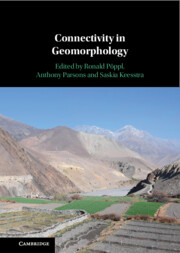Book contents
- Connectivity in Geomorphology
- Connectivity in Geomorphology
- Copyright page
- Contents
- Contributors
- Preface
- Acknowledgements
- Part I Introduction
- Part II Connectivity in Process Domains
- Part III Quantifying Connectivity in Geomorphology
- Part IV Managing Connectivity
- 12 Agricultural Land
- 13 Rivers and Wetland Systems
- 14 Drylands
- 15 Coasts and Deltas
- Index
- References
14 - Drylands
from Part IV - Managing Connectivity
Published online by Cambridge University Press: 10 April 2025
- Connectivity in Geomorphology
- Connectivity in Geomorphology
- Copyright page
- Contents
- Contributors
- Preface
- Acknowledgements
- Part I Introduction
- Part II Connectivity in Process Domains
- Part III Quantifying Connectivity in Geomorphology
- Part IV Managing Connectivity
- 12 Agricultural Land
- 13 Rivers and Wetland Systems
- 14 Drylands
- 15 Coasts and Deltas
- Index
- References
Summary
Vegetation cover in drylands tends to be sparse and organised as a mosaic of patches with high biomass interspersed within a bare soil component. Water availability and vegetation are tightly coupled in these environments, where landscape function is determined by hydrologic and sediment connectivity. In this chapter, we analyse and synthesise previous studies describing how understanding, measuring and modifying connectivity can be used to guide the design of management strategies aiming at improving landscape resilience. We describe how drylands are very sensitive to both water and wind erosion, which have the potential to increase connectivity beyond tipping points at which the system transitions abruptly to a degraded state that may be irreversible. We discuss methods for the identification of early warning indicators of transition to degraded states, which could be used as a preventive management tool. We also describe existing strategies and approaches to reduce connectivity at different spatial scales as a way of managing degraded landscapes.
Keywords
- Type
- Chapter
- Information
- Connectivity in Geomorphology , pp. 355 - 378Publisher: Cambridge University PressPrint publication year: 2025

